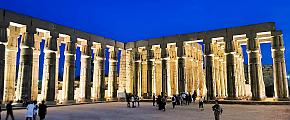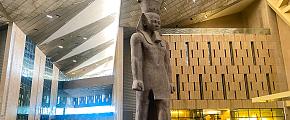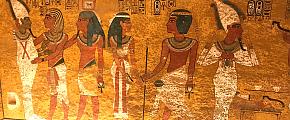All You Need to Know About the Valley of the Kings
People of this planet always find the mysterious architecture of ancient Egypt fascinating, particularly the great pyramids. Do you know that there is another grand place that serves as the royal tombs of pharaohs and other noblemen of ancient Egypt? It is called the Valley of the Kings. If you would like to take a Egypt Tour, you will never miss it!
Where is the Valley of the Kings
In the west bank of the Nile River and in the hills of the barren tract west of Luxor lies the Valley of the Kings. It is only about 45-minute drive from modern Luxor, 3-hour ride from Aswan, and 1-hour air travel from Cairo. Modern transportation has perfectly narrowed down the distance between ancient Egypt and the modern traveler.
A Brief History of the Valley of Kings
It is believed that the Valley of the Kings was built in the Egyptian Old Kingdom, from 1539 BC to 1075 BC, with a time span of around 500 years. Pharaohs of that time, bearing the wish to be close to the source of their dynastic roots, have chosen this saint valley to build their final resting place so as to get ready for their afterlife.
There are 60 more known tombs discovered in the Valley of the Kings, of which around 20 were for the Kings. Thutmose I was the first ruler buried in there and the last one believed to be Ramses X or XI. Among them were some of the most famous figures of ancient Egypt, for example, the boy king Tutankhamun, Ramses the Great, Ramesses IV, and Tuthmosis III.
Buried with a good number of gold and precious treasures, the kings' tombs were always attractive to robbers in an unwanted way. Over time, most of them have been pillaged. While in the 21st century, some tombs were denuded of their contents systematically for the purpose of protection.
Listed as a World Heritage Site by UNESCO in 1979, the Valley of the Kings remains a popular destination for global tourists.
 Valley of Kings
Valley of Kings
Beliefs and Rituals of the Ancient Egyptian Afterlife
The belief of the afterlife was deeply rooted in the hearts of ancient Egyptians. The kings believed that they would continue to live as pharaohs and be close to their gods. Driven by this belief, the kings would always get fully prepared for their new lives.
After death, their bodies would be preserved as mummies wrapped by coils of soft silk, and their faces would be covered with specially made masks. Gold and other treasures will also be buried with them for use in their afterlife.
Specially Designed and Gorgeous Rrnamented Tombs
As the final resting place for the kings, many of the tombs were specially designed to avoid disturbance from robbers. Entrances of some tombs are hidden, and corridors to tombs are deep, long, and zigzagging. Some shafts were particularly built to confuse the tomb raiders. Inside those tombs are small storage chambers housing furniture, food, jewels, and other treasures.
To befit the kings' status, many tombs were gorgeously decorated with precious items. Walls of the tombs had beautiful paintings about the stories of their gods and goddesses, as well as the legends of the pharaohs. There are also hieroglyphic texts written on the walls, which were believed to be the guidance for the kings' afterlives.
Interesting Facts About King Tutankhamun and His Tomb
It is said that King Tutankhamun is one of the most important pharaohs who lived in ancient Egypt. He ascended to the throne as a child after the demise of his father Rameses I. He died after an accident unfortunately, and was buried in this royal place.
The tomb was discovered by Howard Carter in 1922. An astonishing number of gold and precious treasures were uncovered, which has vividly presented how luxurious the burial of a great pharaoh of the empire must have been in its heyday.
Unlike most of the tombs that have been ransacked, the little tomb of king Tutankhamun, protected by a pile of rock chippings thrown down from a later tomb, stayed largely intact. Visitors today have the luck to view all the treasures uncovered in his tomb in the Egyptian Museum.
Another interesting fact is about an alleged curse on King Tutankhamun's tomb. Howard Carter and his team died mysteriously after exhuming the tomb in 1922. This seems to cohere with the belief of local Egyptians that anyone who gets close to, or touches the boy king’s tomb will be cursed. It is said that the spell has been cast by the pharaohs in order to scare off tomb robbers.
An Active Archaeological Site
The Valley of the Kings is not only attractive to tourists, but also to archaeologists and Egyptologists all over the world. Excavations began in the 18th century, and since then several new tombs have been discovered each year. Today the exploration work still continues.
In 1827, John Gardiner Wilkinson first numbered the tombs with KV, the abbreviation for King's Valley, over 21 tombs geographically from the entrance to the southward. This numbering system has been retained since then, and new numbers were assigned in the time order of their discovery. The most recent tombs were numbered as KV 62, KV 63 and KV 64.
 Valley of Kings
Valley of Kings
Tourist Information
Entrance ticket, additional ticket and photo pass
An entrance ticket is required, with which you can visit three tombs out of a list at the most.
There are three extra tombs that require additional tickets.
Photography by cellphone is generally allowed in most of the tombs. A photo pass will be required if other facilities such as DSLR and shoot camera are used. If you shoot videos with your cellphone, you will also need a photo pass.
An entrance ticket is around 245 EPG (about 10 UDS); the extra ticket price varies from 100 EPG (about 4 USD) to 1000 EPG (40 USD); a photo pass costs about 300 EPG (about 12 USD).
Operation hours, open tombs and time of tour
The open hours of the Valley of the Kings are 6 am to 4 pm in winter, and 6 am to 5 pm in summer. The most crowded time is between 10 am and 2 pm. It is better to avoid the busy hours in the Valley.
Most of the tombs are not open to the public due to the continual excavation at the site or preservation and restoration reasons. About ten will open to visitors most of the time.
Here is an example of tombs that opens in July 2022 for your reference:
KV1 - Ramesses VII;
KV6 - Ramesses IX
KV8 - Merenptah
KV11 - Ramesses III
KV14 - Tausert-Setnakht
KV15 - Seti II
KV16 - Ramesses I
KV47 - Siptah
Three tombs require extra tickets:
KV9 - Ramesses V & VI
KV17 - Seti I
KV62 - Tutankhamun
For a leisurely experience, 2 to 3 hours visit will be fine. For a photo-snapping-visit of the three tombs, one hour to one hour and a half will be enough.
Recommended Tombs
KV 17-Seti I is the best tomb in the Valley of the Kings.
Seti is the father of Ramses II and is best known for his remarkable building works during his rule. His tomb is incredible in many ways. Most of the 11 chambers and side rooms are decorated with reliefs. The colors on the walls are some of the most vibrant, and the carvings are also magnificent.
KV 11-Ramesses III is one of the best-preserved tombs in the Valley of the Kings.
Ramesses III ruled the empire for over 31 years. During his time, he faced many political and military challenges but managed to defend against many invasions.
His tomb is massive, with a steep staircase covered in detailed reliefs leading down to broad corridors embellished with hieroglyphs. Besides, the main corridor connecting the hall has one of the most magnificent astronomical ceilings in the Valley of the Kings.
KV 62- Tutankhamun is the most famous tomb in the Valley of kings.
Being a boy king who died untimely at an early age, Tutankhamun's tomb was built in a hurry, with a narrow chamber that lacks carvings. What makes it famous are the invaluable treasures, including his famous golden headdress uncovered in the tomb and his mummy that stayed intact in the coffin.
Other Practice Tips
Bring enough cash to cover your tickets, snacks or drinks and tips for possible services in the Valley.
Bring sunscreen to protect your skin from exposure to the strong sunlight while traveling from tomb to tomb.
Make sure to purchase all the tickets, including the photo pass, at the visitor center at one time. Once entering the Valley of the Kings, visitors cannot purchase any tickets. If an extra ticket is needed, one will have to return to the visitor center again.
For more information you want to know, just simple contact Odynovo and get professional suggestion.
Quick Question
What Our Clients Say
"Great Service and Value", "Exceed All Expectations", "Highly Recommend".SUBSCRIBE TO WIN A FREE TOUR
Subscribe to our newsletter for a chance to win a free 6-day Bali vacation! And more insider travel news, exclusive offers, and inspiration will be sent straight to your inbox.







